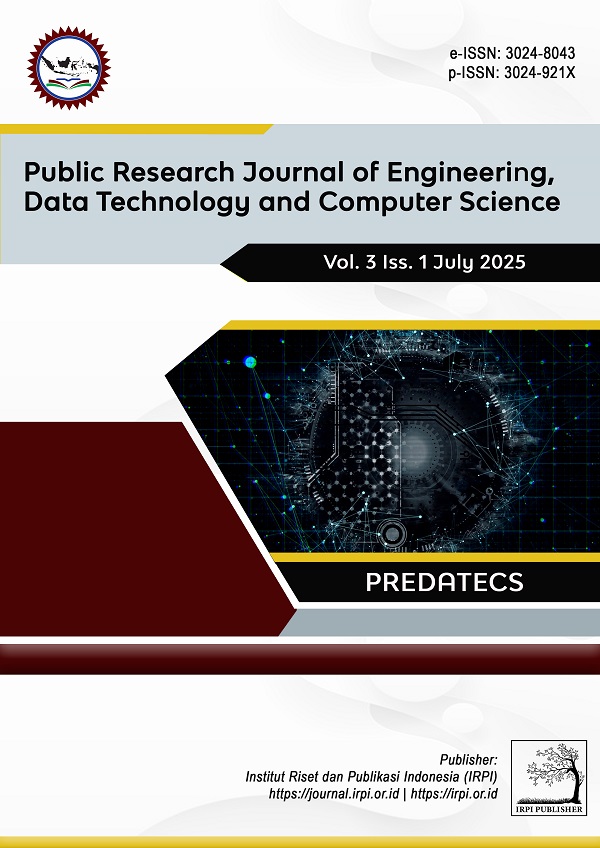Leveraging Machine Learning for Early Risk Prediction in Cirrhosis Outcome Patients
DOI:
https://doi.org/10.57152/predatecs.v3i1.2015Keywords:
Cirrhosis Prediction, Clinical Decision Support, Machine learning, Medical Data, XGBoostAbstract
Millions of individuals worldwide suffer from liver cirrhosis, which is one of the primary causes of mortality. Healthcare professionals may have more opportunities to treat cirrhosis patients effectively if early death prediction is made and it is postulated that death in this cohort would be correlated with laboratory test findings and other relevant diagnoses. In this study five machine learning models, including LR, SVM, XGBoost, AdaBoost and KNN, are implemented and evaluated. The preprocessing steps included feature selection, categorical data encoding, and data balancing using SVMSMOTE. The XGBoost model demonstrated superior performance, achieving 89.55% accuracy, 89.69% precision, 89.55% recall, and an F1-score of 89.59% after balancing. These findings highlight the potential of machine learning models in accurate risk detection in patients with cirrhosis and providing valuable support in clinical decision-making and improving patient treatment.
References
X. Shu dan and Y. Ye, “Knowledge Discovery: Methods from data mining and machine learning,” Social Science Research, vol. 110, no. 1, p. 102817, 2023,doi: 10.1016/j.ssresearch.2022.102817.
H. Innes, J. R. Morling, S. Buch, V. Hamill, F. Stickel dan and I. N. Guha, “Performance of routine risk scores for predicting cirrhosis-related morbidity in the community,” Journal of Hepatology, vol. 365–376, no. 2, p. 365–376, 2022,doi: 10.1016/j.jhep.2022.04.031.
A. K. Le, H.-I. Yang, M.-L. Yeh, M. Jin, H. N. Trinh, L. Henry dan and A. Liu, “Development and validation of a risk score for liver cirrhosis prediction in untreated and treated chronic hepatitis B,” The Journal of Infectious Diseases, vol. 223, no. 1, p. 139–146, 2021, : 10.2196/24305.
Y.-J. Lin, R.-J. Chen, J.-H. Tang, C.-S. Yu, J. L. Wu, L.-C. Chen dan and S.-S. Chang, “Machine-learning monitoring system for predicting mortality among patients with noncancer end-stage liver disease: retrospective study,” JMIR Medical Informatics, vol. 8, no. 10, p. e24305, 2020.
G. Chongo dan and J. Soldera, “Use of machine learning models for the prognostication of liver transplantation: A systematic review,” World Journal of Transplantation, vol. 14, no. 1, p. 88–891, 2024,doi: 10.5500/wjt.v14.i1.88.
F. Rahman, D. Das, A. Sami, P. Podder dan and D. L. Michael, “Liver cirrhosis prediction using logistic regression, naïve Bayes and KNN,” International Journal of Science and Research Archive, vol. 12, no. 01, p. 2411–2420, 2024.
R. Amin, R. Yasmin, S. Ruhi, M. H. Rahman dan and M. S. Reza, “Prediction of chronic liver disease patients using integrated projection based statistical feature extraction with machine learning algorithms,” Informatics in Medicine Unlocked, vol. 36, p. 101155, 2023,doi: 10.1016/j.imu.2023.101155.
M. P. Behera, A. Sarangi, D. Mishra dan and S. K. Sarangi, “A hybrid machine learning algorithm for heart and liver disease prediction using modified particle swarm optimization with support vector machine,” Procedia Computer Science, vol. 218, p. 818–827, 2023.
D. S. Ali dan and M. Aljabery, “Predicting Stages of Liver Cirrhosis Using Data Mining and Machine Learning Techniques,” Informatica, vol. 48, no. 21, 2024.
A. Utku, “Deep Learning Based Cirrhosis Detection,” Operational Research in Engineering Sciences: Theory and Applications, vol. 6, no. 1, 2023.
O. M. Güne?, P. Kasap dan and B. S. Ç. Zorlu, “The comparison of machine learning classification algorithms used to diagnose liver cirrhosis disease and a brief review,”
Concurrency and Computation: Practice and Experience, vol. 35, p. e7628, 2023.
K. Prakash dan and S. Saradha, “A deep learning approach for classification and prediction of cirrhosis liver: non alcoholic fatty liver disease (NAFLD),” dalam 6th International Conference on Trends in Electronics and Informatics (ICOEI), 2022.
“Multi-Class Prediction of Cirrhosis Outcomes,” Kaggle, 2023. [Online]. Available: https://www.kaggle.com/competitions/playground-series-s3e26.
I. M. El-Hasnony, S. I. Barakat, M. Elhoseny dan and R. R. Mostafa, “mproved feature selection model for big data analytics,” IEEE Access, vol. 8, p. 66989–67004, 2020.
N. Kosaraju, S. R. Sankepally dan and K. M. Rao, “Categorical data: Need, encoding, selection of encoding method and its emergence in machine learning models—a practical review study on heart disease prediction dataset using Pearson correlation,” dalam International Conference on Data Science and Applications (ICDSA), 2023,doi: 10.1007/978-981-99-3863-6_29.
S. Seshagiri dan and K. V. Prema, “Efficient handling of data imbalance in health insurance fraud detection using meta-reinforcement learning,” IEEE Access, 2025.
O. A. Montesinos López, A. Montesinos López dan and J. Crossa, “Overfitting, model tuning, and evaluation of prediction performance,” Springer International Publishing, p. 109–139, 2022,doi: 10.1007/978-3-030-89010-0_5.
Z. Khandezamin, M. Naderan dan and M. J. Rashti, “Detection and classification of breast cancer using logistic regression feature selection and GMDH classifier,” Journal of Biomedical Informatics, vol. 111, p. 103591, 2020.
A. Bilal, A. Imran, T. I. Baig, X. Liu, E. A. Nasr dan and H. Long, “Breast cancer diagnosis using support vector machine optimized by improved quantum inspired grey wolf optimization,” Scientific Reports, vol. 14, no. 1, p. 10714, 2024, doi: 10.1038/s41598-024-58700-1.
P. Limbulkar, S. Gupta, P. Gawade dan and K. Saxena, “Investigating the efficacy of gradient boosting for skin type classification,” dalam International Conference on ICT for Sustainable Development, 2024.
S. Gamil, F. Zeng, M. Alrifaey, M. Asim dan and N. Ahmad, “An efficient AdaBoost algorithm for enhancing skin cancer detection and classification,” Algorithms, vol. 17, no. 8, p. 353, 2924,doi: 10.3390/a17080353.
K. Moon dan and A. Jetawat, “Predicting lung cancer with K-nearest neighbors (KNN): A computational approach,” Indian Journal of Science and Technology, vol. 17, no. 21, p. 2199–2206, 2024.
Downloads
Published
How to Cite
Issue
Section
License
Copyright (c) 2025 Yasir Hussein Shakir, Eshaq Aziz Awadh AL Mandhari, Ali Alkhazraji

This work is licensed under a Creative Commons Attribution-ShareAlike 4.0 International License.
Copyright © by Author; Published by Institut Riset dan Publikasi Indonesia (IRPI)
This Public Research Journal of Engineering, Data Technology and Computer Science is licensed under a Creative Commons Attribution-ShareAlike 4.0 International License.












